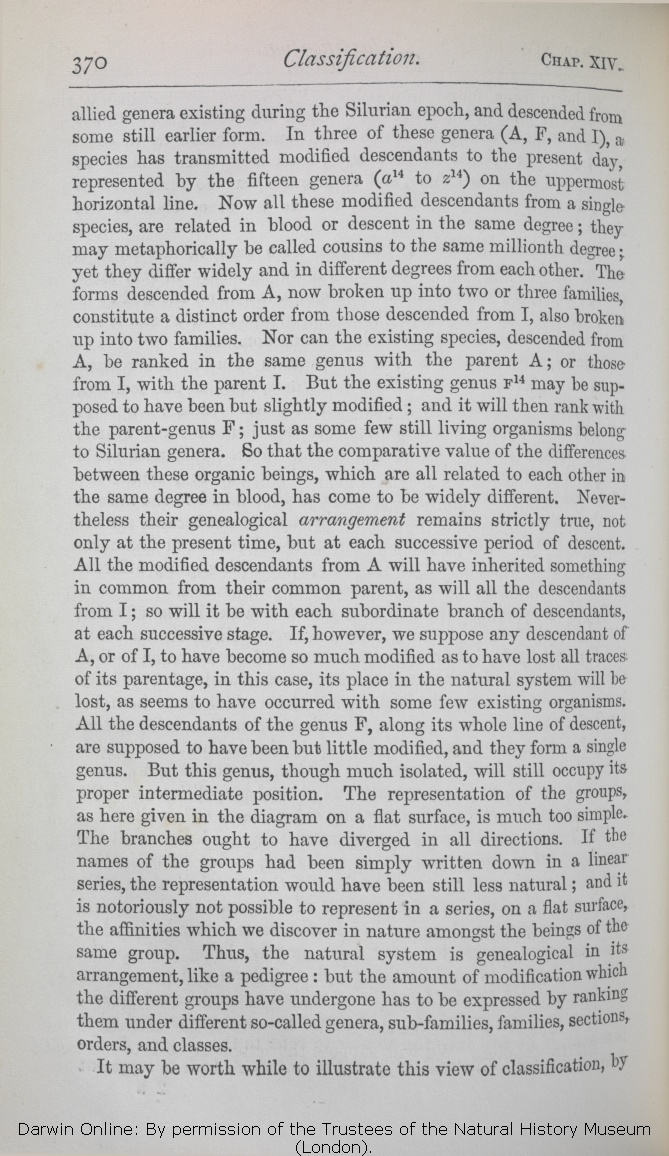allied genera existing | allied genera existing 1872 |
| allied genera, which lived 1859 1860 1861 1866 |
| OMIT 1869 |
| epoch, 1859 1860 1861 1866 1872 | | epoch 1869 |
| and 1872 |
| and these have 1859 1860 1861 1866 |
| allied genera, 1869 |
| some still earlier form. 1872 |
| a species which existed at an unknown anterior period. 1859 1860 1861 1866 |
| some still earlier forms. 1869 |
| In 1869 1872 | | Species of 1859 1860 1861 1866 |
| I), a species has 1872 |
| I) have 1859 1860 1861 1866 |
| I) the species have 1869 |
|
to
1872 | | to 1859 1860 1861 1866 1869 |
| ..... 1869 1872 | | represented as 1859 1860 1861 1866 |
| in 1872 | | to 1859 1860 1861 1866 1869 |
| organisms 1869 1872 | | organic beings 1859 1860 1861 1866 |
| comparative 1872 | | amount or 1859 1860 1861 1866 1869 |
| these organic beings, which are 1872 |
| organic beings 1859 1860 1861 1866 |
| these organic beings which are 1869 |
| stage. 1869 1872 | | period. 1859 1860 1861 1866 |
| suppose any 1869 1872 |
| choose to suppose that any of the 1859 1860 1861 1866 |
| descendant 1869 1872 | | descendants 1859 1860 1861 1866 |
| A, 1872 | | A 1859 1860 1861 1866 1869 |
| I, to have become 1872 |
| I have been 1859 1860 1861 1866 |
| I to have been 1869 |
| lost all 1869 1872 |
| more or less completely lost 1859 1860 1861 1866 |
| its 1869 1872 | | their 1859 1860 1861 1866 |
| its 1869 1872 | | their 1859 1860 1861 1866 |
| place 1869 1872 | | places 1859 1860 1861 1866 |
| the 1869 1872 | | a 1859 1860 1861 1866 |
| system 1869 1872 | | classification 1859 1860 1861 1866 |
| be lost, as 1872 |
| have been more or less completely lost,— as sometimes 1859 1860 1861 1866 |
| likewise be lost,— as 1869 |
| some few existing 1869 1872 |
| existing 1859 1860 1861 1866 |
| ..... 1869 1872 | | yet 1859 1860 1861 1866 |
| 2 blocks not present in 1872; present in 1859 1860 1861 1866 1869 | | But this genus, though much isolated, will still occupy its proper intermediate position;
for F originally was intermediate in character between A and I, and the several genera descended from these two genera will have inherited to a certain extent their characters. This natural arrangement is shown,
as
far as is possible on paper, in the diagram,
but in much too simple a manner.
|
| OMIT 1872 |
| a branching diagram had not been used, and only 1859 1860 1861 1866 1869 |
| simply written down 1872 |
| written 1859 1860 1861 1866 1869 |
| the representation 1872 | | it 1859 1860 1861 1866 1869 |
| natural; 1872 |
| possible to have given a natural arrangement; 1859 1860 1861 1866 1869 |
| ..... 1872 | | on 1859 1860 1861 1866 1869 |
| OMIT 1872 |
| view which I hold, the 1859 1860 1861 1866 1869 |
| arrangement, 1859 1860 1861 1869 1872 | | arrange- ment, 1866 |
| pedigree: 1872 | | pedigree; 1859 1860 1861 1866 1869 |
| amount 1869 1872 | | degrees 1859 1860 1861 1866 |
| undergone 1869 1872 | | undergone, 1859 1860 1861 1866 |
| has 1869 1872 | | have 1859 1860 1861 1866 |
|









